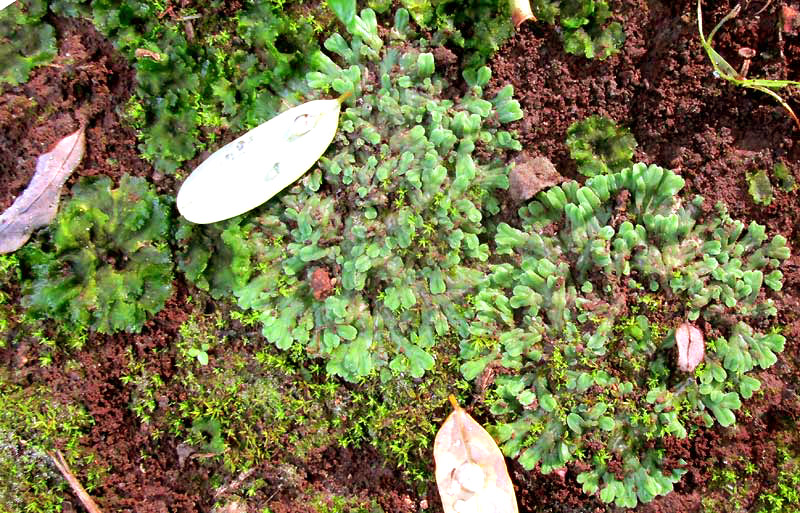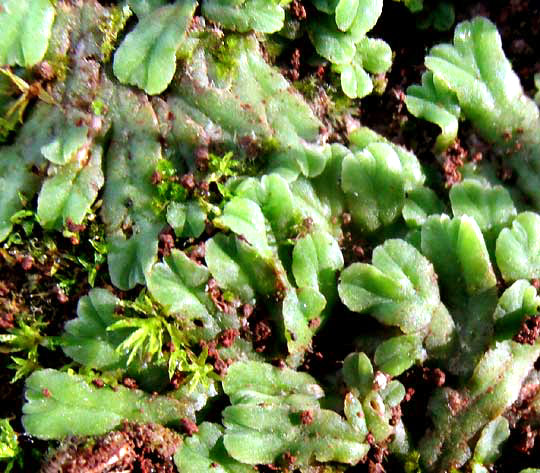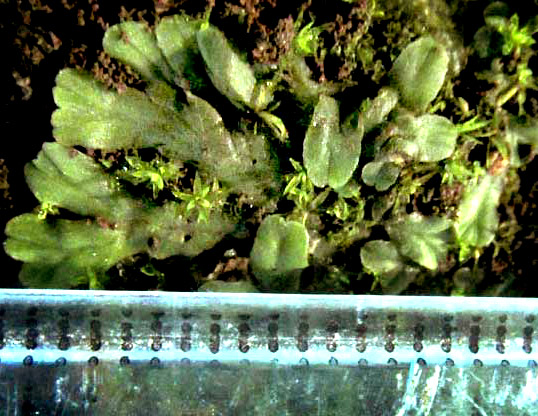Excerpts from Jim Conrad's
Naturalist Newsletter

from the November 1, 2015 Newsletter issued from Hacienda Chichen Resort beside Chichén Itzá Ruins, central Yucatán, MÉXICO
RICCIA LIVERWORT
As the rainy season slowly draws to a close, vegetation is luxuriantly green, the air humid and the ground moist to soggy. Trails through the forest are shadowy and somber. On naked dirt on one of those trails near the Hacienda, a kind of plant turned up that often is spotted up north, but in this area with its long, severe dry seasons, seldom is encountered. Above, you can see three patches of them, which are up to about 4cm broad (1½ inch), and with their ribbon-like bodies growing outward from each colony's center.
These are liverworts -- bryophytes like mosses. Their bodies lack a vascular system, so there's no xylem and phloem through which water, nutrients and photosynthesized material can flow. Like mosses, liverworts reproduce with spores, not flowers and fruits. Having no vascular system, the flat, leafy bodies in the picture consist of flat layers of cells. Below, a closer look at the bodies -- which among liverworts are known as thalli (singular thallus) -- is shown:

As thallose liverworts go, this is a small-bodied species, its typical thallus width being only about 2mm (0.08 inch), as shown below:
 .
.
It's unusual to find liverworts in this part of the world because of the long dry seasons. Reproduction in liverworts need moisture if only because their sperm must swim from male organs to female ones. It's also unusual to find loose, naked soil such as that on which these liverworts were growing. Pocket gophers had been throwing up hills in the area and it looked like the liverworts were colonizing an old gopher disturbance. And one has to wonder where the pioneering spores came from, since this is the first time I've seen them in all the Yucatan.
Since liverworts reproduce with dust-like spores that can be carried by the wind, their species often occur throughout much of the world. Without a microscope and reproductive material I can't identify this species with certainty, but I can say that it looks very much like one of the most common and widespread liverwort species in the world, one usually found on bare soil, often along footpaths and other disturbed areas, on both acidic and base-rich soils, and one that is thought of as easily recognizable because of its uniformly green, small thalli with a very conspicuous groove running down each thallus's middle, forming a Y where the thallus divides. And that species is RICCIA SOROCARPA. That name is an educated guess for what's in our picture, and nothing more, though Riccia sorocarpa has been recorded in Mexico, the Caribbean area and several tropical countries.
In England, Riccia sorocarpa sometimes is known as the Common Crystalwort, but most liverwort fanciers just call species of the genus Riccia Riccias.